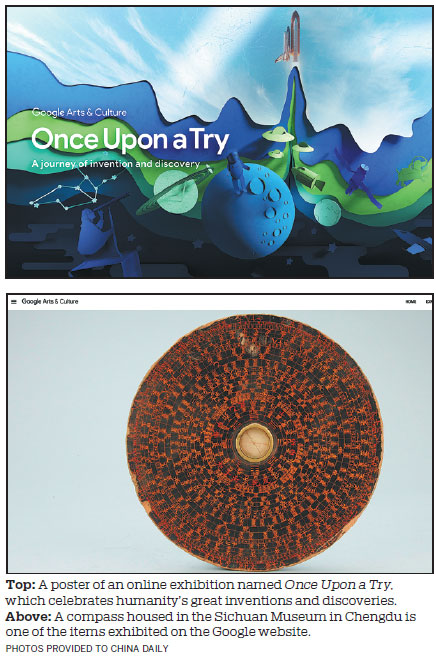Once Upon a Try: The art of discovery and invention
Many stories regarding three of ancient China's "four great inventions" - namely the compass, gunpowder and papermaking - are featured in an online exhibition launched by Google Arts & Culture on March 6.
Eight Chinese cultural institutions, including the Palace Museum and the Art Museum of the Central Academy of Fine Arts in Beijing, are taking part in the digital exhibition.
A documentary about contemporary artist Cai Guoqiang - who is known for creating art using gunpowder - and works by him also form part of the exhibition.
Under the name Once Upon a Try, the online exhibition is a tribute to the stories of humanity's great inventions and discoveries.
Leading science centers such as the United States' National Aeronautics and Space Administration and the Swiss-based European Council for Nuclear Research are among the 119 partners from 23 countries that are taking part in the exhibition.
The project is helping to raise the international profile of the Shu culture of Southwest China's Sichuan province globally, according to Zhang Heng, director of the publicity department of the Sichuan Museum. Shu is a Chinese character that refers to Sichuan.
This is the first time collections from the Sichuan Museum and Wuzhen - the ancient water town in eastern Zhejiang province that's famous for hosting the annual World Internet Conference and Theater Festival - have appeared on the platform.
A total of 192 exhibits about human creativity and inventions from the Sichuan Museum are on display, including items related to the Dujiangyan Irrigation System, a UNESCO world heritage site, and its prestigious collection of Shu brocades, compasses, brick reliefs from the Han Dynasty (206 BC-AD 220) and examples of guqin, the ancient Chinese seven-stringed zither.
The first compasses date back to the Warring States Period (475-221 BC), while the earliest texts about their use in marine navigation appeared around the end of the 11th century.
The compasses were first used in fortunetelling, sacred ceremonies and rituals, before being put to use in the fields of construction, farming, mining and the military.
Compasses from the Sichuan Museum usually contain magnetite, a naturally magnetic mineral, and are shaped into wooden discs with patterns and characters inscribed in the concentric circles on them, conveying the ancient people's knowledge of constellations, chronology and the natural elements.
Sixty one of the exhibits were shot using Google's high-definition system which captures images at a resolution of over a billion pixels.
Zhang says she hopes the online exhibition will send a positive signal to young people interested in learning more about technology and improving their perception of human culture and civilizations.
She expects more interactive activities to be launched in cooperation with the platform.
Other highlighted exhibits from China include a set of stone drums housed in the Palace Museum that date back to the Qin state during the Warring States period.
These treasures are inscribed with the earliest known Chinese texts carved in stone and the poetry carved on each of them describe the king of the Qin state's love for hunting and travel, and the beautiful landscapes of the time.
"We are particularly happy to work with Chinese institutions that provide such a wide, diverse and historically significant heritage," says Pierre Caessa, program manager of Google Arts& Culture.
"We believe that more access to culture online will generate a greater appetite for people to go and visit museums in person," Caessa says.
According to Luisella Mazza, head of global operations for Google Arts& Culture, there is increasing interest in cultural artifacts from China and a rise in the number of related virtual museum visits.
The platform also aims to explore the connections between different cultures. For example, they made short video series examining the origins of subjects as diverse as soccer and mathematics.
The exclusive documentary named Cai Guoqiang and da Vinci: Painting with Gunpowder is another example of how the platform attempts to connect the East and the West.
Cai is best known for his fireworks installations, including his work Footprints of History, which he created for the 2008 Beijing Olympics, and Sky Ladder.
Gunpowder was accidentally discovered around the 9th century by Taoist alchemists who were looking to enhance longevity. Cai used the same techniques to make fireworks as he did to create his paintings.
He created a firework rainbow in New York City in 2002 to symbolize rebirth and hope in the wake of the Sept 11, 2001 terrorist attacks, and in 2008, he created a daytime show using black fireworks to resemble the mushroom cloud in Hiroshima, to convey social and political meanings.
Cai also views the documentary as a salute to Leonardo da Vinci, the Renaissance figure who was fond of gunpowder and had designed weapons that channeled its immense power.
To mark the 500th anniversary of da Vinci's death this year, Cai created a painting under the name, Study of Birds.
He magnifies the Italian master's sketches onto a large canvas, carves the outlines with a knife, fills in the blanks with gunpowder and then detonates the work as he introduces it in the documentary.
The painting was displayed at his 2018 solo exhibition Flora Commedia at the Uffizi Gallery in Florence, Italy, which opened after his daytime firework performance, City of Flowers in the Sky.
Cai especially enjoys some of the painter's more obscure doodles, such as detailed drawings of the hairs on a bird's feet or the sensual, parted lips of a man's mouth.
"Da Vinci's observations were amazing. He had designed various novel devices and methods to explore nature, which blurred the boundary of art and science, reality and fantasy," Cai says, adding that he was impressed that the master was as curious and free as a child, while he maintained his genius for imagination.
"I myself like playing with fire and the feeling of losing control, acting at random and encountering unexpected things - just as I did when I was a boy," says the 62-year-old.
fangaiqing@chinadaily.com.cn

(China Daily 04/11/2019 page14)


















